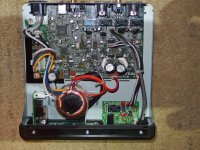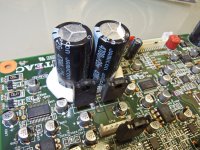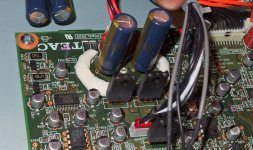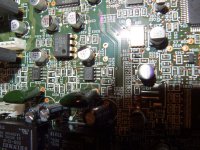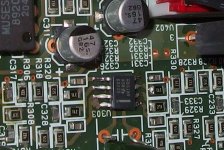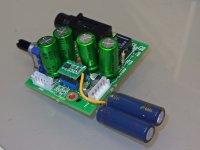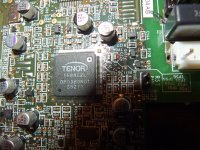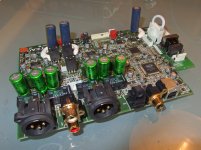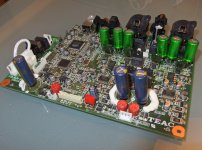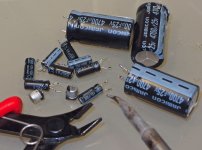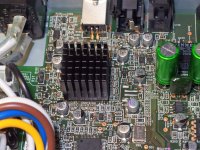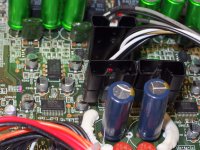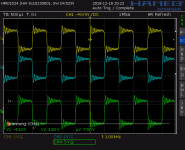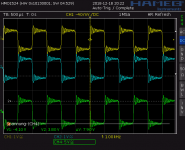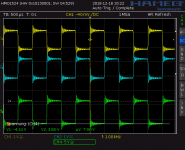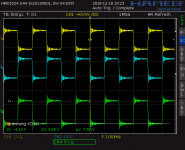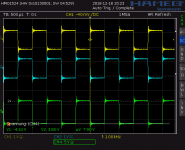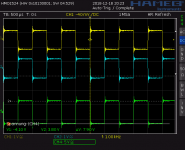This was the first hifi gear I deliberately bought to be modified.
Besides being advertised by lots of sells babble and having award winning specs, it simply sounds awful, especially on the headphone out. Protruding mids, anaemic, clinical and absolutely nothing to fall in love with regarding sound rendering.
But as those can be picked up pretty cheap second hand, which really is no wonder, and as they can almost play each and every digital format and have a nice footprint, I gave it a shot.
TEAC does use crappy Jamicon electrolytics not only as reservoir caps but also for coupling, hence it was a no brainer to replace them. Did use Nichicon FC and Nichicon bipolar ones for coupling. Quite any choice will be better than those Jamicon I guess.
The HP section is built around the NJM 4580. Though not that bad, for cans of lower impedance and at rather elevated levels it runs out of steam. The logical choice for me was to replace it by the OPA1622 which can output roughly 140mA. I also bypassed the relay driven muting circuit as this adds roughly 100 ohm output impedance.
The symmetric line out section is built around the inferior NE5532 which I replaced by OPA2209.
All in all, presentation came greatly to live by above modifications. Love it already.
Things left to be done:
Heat sink for the TENOR chip, as this one runs really hot
Dig up and replace some "hidden" SMD coupling lytics. No schematics available so I have to spend same more time on that.
Besides being advertised by lots of sells babble and having award winning specs, it simply sounds awful, especially on the headphone out. Protruding mids, anaemic, clinical and absolutely nothing to fall in love with regarding sound rendering.
But as those can be picked up pretty cheap second hand, which really is no wonder, and as they can almost play each and every digital format and have a nice footprint, I gave it a shot.
TEAC does use crappy Jamicon electrolytics not only as reservoir caps but also for coupling, hence it was a no brainer to replace them. Did use Nichicon FC and Nichicon bipolar ones for coupling. Quite any choice will be better than those Jamicon I guess.
The HP section is built around the NJM 4580. Though not that bad, for cans of lower impedance and at rather elevated levels it runs out of steam. The logical choice for me was to replace it by the OPA1622 which can output roughly 140mA. I also bypassed the relay driven muting circuit as this adds roughly 100 ohm output impedance.
The symmetric line out section is built around the inferior NE5532 which I replaced by OPA2209.
All in all, presentation came greatly to live by above modifications. Love it already.
Things left to be done:
Heat sink for the TENOR chip, as this one runs really hot
Dig up and replace some "hidden" SMD coupling lytics. No schematics available so I have to spend same more time on that.
Attachments
Last edited:
Why did you leave the I/V opamp (NJM Muse). I'd rather replace that for a high speed opamp like an OPA2156/THS4032/ADAU4898 and leave those NE5532 in.
You could also try to lower the Iref resistor from the PCM1795s to around 6k (designated R300 and R200).
Why didn't you buy caps that fit? (kleiner Scherz...)
You could also try to lower the Iref resistor from the PCM1795s to around 6k (designated R300 and R200).
Why didn't you buy caps that fit? (kleiner Scherz...)
Why did you leave the I/V opamp (NJM Muse).
Has anyone ever had experience with MUSE opamps?
No way I ever will warm up with NE5532and leave those NE5532 in.
Don't even have a clue what stock Iref resistor is in there. No schematics availableYou could also try to lower the Iref resistor from the PCM1795s to around 6k (designated R300 and R200).
Why didn't you buy caps that fit? (kleiner Scherz...)
Last edited:
Will try to substitute the headphone board with a OPA1620 EVAL board that is said to arrive around Christmas. Less guesswork for modding, as no schematics from TEAC available.
Occasionally the OPA1622 at the plug in adapter board gets into distortion mode with my 60ohm cans, some oscillation I guess.
Was not able to trace it down because it worked ok as soon as I hooked up my oscilloscope.
Occasionally the OPA1622 at the plug in adapter board gets into distortion mode with my 60ohm cans, some oscillation I guess.
Was not able to trace it down because it worked ok as soon as I hooked up my oscilloscope.
Last edited:
There are two drawbacks for the TPA6120 compared to the OPA1622 / INA1620 as I can tell from data sheets.
First the PSRR of the TPA6120 is around 80dB at best whereas the OPA1622 / INA1620 comes with stellar 140dB and second the TPA6120 is not stable on headphones without an output resistor.
Especially the second disadvantage definitely keeps me from trying, but thanks for your recommendation anyway.
There is an elegant way to further improve upon stability for the OPA1622 / INA1620 I have stumbled across lately:
http://www.ti.com/lit/an/slyt630/slyt630.pdf
Don't think this would also work for a current feedback opamp like the TPA6120
First the PSRR of the TPA6120 is around 80dB at best whereas the OPA1622 / INA1620 comes with stellar 140dB and second the TPA6120 is not stable on headphones without an output resistor.
Especially the second disadvantage definitely keeps me from trying, but thanks for your recommendation anyway.
There is an elegant way to further improve upon stability for the OPA1622 / INA1620 I have stumbled across lately:
http://www.ti.com/lit/an/slyt630/slyt630.pdf
Don't think this would also work for a current feedback opamp like the TPA6120
Well, having some resistors at the output isn't such a bad thing, it is also there to avoid short circuits that happen with those TRS connectors.
On the other side, the INA1620 that you've mentioned looks indeed very interesting, I might have to order the EVM too.
On the other side, the INA1620 that you've mentioned looks indeed very interesting, I might have to order the EVM too.
Last edited:
Ad TPA6120: The output resistor of those boards is only 10 Ohms as well. But to mod it to balanced input you need 0603 resistors (well, I've managed to fit 0805 there). Fortunately the PCB layout is prepared for balanced input.
I'd even thought on paralleling them to drive the tweeter of my active monitors
... AND: Be aware, all my boards had the supply caps reversed! Even the silkscreen is wrong.
Having read the NJM Muse datasheet again, I'd really recommend to get rid of that and replace it with an opamp that has higher GBW. Solder the SO8-DIP adapter directly onto the PCB, those socket connectors do no good as I have experienced with my PCM1794a DAC (and likely I've seen on your HP amp board). Maybe you can re-use those "miracle opamps" somewhere other.
If you're on it, replace those 47µF 'lytics around the DACs with something like SMD polymer tantalums.
The Iref resistors (R200 & R300) are nominally 10k, according to Doede Duma (DDDAC) he's got best results with 6K8. I'm not sure since this applies to a PCM1794a and PCM1795 is different in that it output current is only half of that.
I'd even thought on paralleling them to drive the tweeter of my active monitors
... AND: Be aware, all my boards had the supply caps reversed! Even the silkscreen is wrong.
Having read the NJM Muse datasheet again, I'd really recommend to get rid of that and replace it with an opamp that has higher GBW. Solder the SO8-DIP adapter directly onto the PCB, those socket connectors do no good as I have experienced with my PCM1794a DAC (and likely I've seen on your HP amp board). Maybe you can re-use those "miracle opamps" somewhere other.
If you're on it, replace those 47µF 'lytics around the DACs with something like SMD polymer tantalums.
The Iref resistors (R200 & R300) are nominally 10k, according to Doede Duma (DDDAC) he's got best results with 6K8. I'm not sure since this applies to a PCM1794a and PCM1795 is different in that it output current is only half of that.
Where do you get the TI-EVM from? Digikey's shipment costs are rather high... The INA1620 really seems to be excellent. Thx!
http://www.ti.com/tool/INA1620EVM
go to "order now"
Thanks!... AND: Be aware, all my boards had the supply caps reversed! Even the silkscreen is wrong.
Will use them single ended for simplicity
Those are gonna to stay.Having read the NJM Muse datasheet again, I'd really recommend to get rid of that and replace it with an opamp that has higher GBW.
In the thread I linked the real interesting thing is that so many have had commented without have given it a try.
Those who did, clearly did vote as for its outstanding musicality, as I would have assumed from a NJM device anyway.
I always found NJM opamps superior in this respect, specs simply don't reflect this.
I even may roll the OPA2209 for a NJM2068 at a time I have further familiarized with the TEAC feeding an external HP amp
Maybe some anecdotal background to highlight my preferences.
NJM seems to be very successful in tracing down musical aspects and in incorporate related key design parameters for many years now.
This I first came across some decades ago when I modded my first consumer grade Philips CD player that had decent sound. Not on par with the qualities of my Sondec / Ittok / Karma of course but quite listenable. Any improvement on the power supply was rewarded by the MJN chips in there with an audible increase of musicality.
At this time NJM opamps were not available here, so I bought some as expensive spare parts through a local Pilips service partner.
Times have changed since.
On the other side of early commercially sound orientated chip designs was the SSM line developed by PMI, which has, after some acquisitions, finally arrived at TI. The most well know part of this line may perhaps have been the SSM2017 which I used as a front end for an instrumentation amp for a by then 16bit sound card.
This SSM2017 in ceramic package I had to order directly from PMI and it arrived with a declaration of the US Defence Department to my surprise. Seems they looked at this parts to be sort of a military secret.
Times have changed since.
By now even TI mammoth has put up sound related series and invested in auditioning facilities to get a better grip on the mystery of sound perception.
Quite a development to look at these things over the past years and decades.
NJM seems to be very successful in tracing down musical aspects and in incorporate related key design parameters for many years now.
This I first came across some decades ago when I modded my first consumer grade Philips CD player that had decent sound. Not on par with the qualities of my Sondec / Ittok / Karma of course but quite listenable. Any improvement on the power supply was rewarded by the MJN chips in there with an audible increase of musicality.
At this time NJM opamps were not available here, so I bought some as expensive spare parts through a local Pilips service partner.
Times have changed since.
On the other side of early commercially sound orientated chip designs was the SSM line developed by PMI, which has, after some acquisitions, finally arrived at TI. The most well know part of this line may perhaps have been the SSM2017 which I used as a front end for an instrumentation amp for a by then 16bit sound card.
This SSM2017 in ceramic package I had to order directly from PMI and it arrived with a declaration of the US Defence Department to my surprise. Seems they looked at this parts to be sort of a military secret.
Times have changed since.
By now even TI mammoth has put up sound related series and invested in auditioning facilities to get a better grip on the mystery of sound perception.
Quite a development to look at these things over the past years and decades.
Last edited:
This I first came across some decades ago when I modded my first consumer grade Philips CD player that had decent sound.
Now I know why you use Nichicon Muse caps
Attachments
Last edited:
Not exactly, these I came across more recently when digging into the topic of measuring lytics:

Nichicon Muse ES bipolar caps measured: <-120dB THD, <-140dB IMD
and some others pioneered by Cyril Bateman that got equally exceptional measurements for the bipolar Nichicons
Cyril Bateman's Capacitor Sound articles | Linear Audio NL
By the way.
I did add an out resistor of 5.6ohm to the OPA1622 and oscillation did't show up again until now.
Nichicon Muse ES bipolar caps measured: <-120dB THD, <-140dB IMD
and some others pioneered by Cyril Bateman that got equally exceptional measurements for the bipolar Nichicons
Cyril Bateman's Capacitor Sound articles | Linear Audio NL
By the way.
I did add an out resistor of 5.6ohm to the OPA1622 and oscillation did't show up again until now.
Last edited:
It also renders sound to the better now, more balanced between treble and bass.By the way.
I did add an out resistor of 5.6ohm to the OPA1622 and oscillation did't show up again until now.
Maybe OPA1622 , just plugged in that way I did, has been operating way too close to the onset of oscillation having too low a phase margin when driving the AKG K701.
Hard to verify by measurement.
Last edited:
Now that I might have spotted the most delicate points in hardware and elaborated for me a way to improve hardware sonics - though not yet fully there - I started to dig into behaviour of reconstruction filters at various bit rates.
All measurements shown were taken with 16bit square wave files created by Audacity at 0dB (more to that later). Yellow and blue trace are XLR hot/ cold, green trace is HP out.
24bit output looks no different.
Here are given some easy to read explanations on the topic of reconstruction filters to compare with:
High resolution audio, asynchronous USB, oversampling, upsampling and stuff: The current state of affairs – Audial
All measurements are taken from the TEAC UD-H01 fed by a Linux/ Ubuntu PC through Guayadeque Music Player.
This one can be configured to output directly to ALSA layer, and thus circumvents the system wide used PulseAudio layer. PulseAudio seems to resample each and evertyhing into 48kHz before passing to USB, if any PC sounds must be mixed.
All measurements shown were taken with 16bit square wave files created by Audacity at 0dB (more to that later). Yellow and blue trace are XLR hot/ cold, green trace is HP out.
24bit output looks no different.
Here are given some easy to read explanations on the topic of reconstruction filters to compare with:
High resolution audio, asynchronous USB, oversampling, upsampling and stuff: The current state of affairs – Audial
All measurements are taken from the TEAC UD-H01 fed by a Linux/ Ubuntu PC through Guayadeque Music Player.
This one can be configured to output directly to ALSA layer, and thus circumvents the system wide used PulseAudio layer. PulseAudio seems to resample each and evertyhing into 48kHz before passing to USB, if any PC sounds must be mixed.
Attachments
- Status
- This old topic is closed. If you want to reopen this topic, contact a moderator using the "Report Post" button.
- Home
- Source & Line
- Digital Source
- don't trash your TEAC UD-H01 DAC, pimp it!
